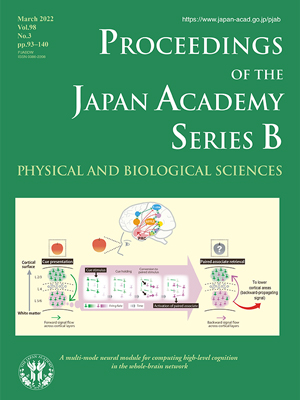About the Cover
Vol. 98 No. 3 (2022)
The cerebral cortex is a massive parallel computing machine. The parallel architecture is believed to be the basis of highly efficient brain computation despite the operating speed of single neurons being extremely slow (~103Hz) compared to that of current silicon hardware (~1012Hz). The structure and dynamics of a parallel processing unit have been most intensively examined in the primary visual cortex (V1). However, the V1-type model has limitation; it supposedly operates mostly in a feedforward manner in its within-unit, across-unit, and across-areal signal flow, because V1 is located at the entry of cortical visual processing. In fact, the cerebral cortex computes high-level cognition in the association cortices, where both feedforward and feedback signal processing should prevail. The review by Miyashita on pages 93-111 presents the “dynamic multimode module (D3M),” a new local circuit model for cortical parallel computation. The D3M engages in feedforward and feedback signaling depending on cognitive demands. A whole-brain network for high-level cognition comprises D3M aggregates. The top panel of the front page shows that, in the whole-brain semantic memory network, many modality-specific areas represent “semantic meaning” such as an aspect of conceptual knowledge (e.g., the word, “apple”), an object feature (e.g., color of an apple), and/or an object-associated feature (e.g., shape of an apple tree). Each modality specific area (node) is linked with a supramodal hub (e.g., perirhinal cortex, PRC). In semantic recall, the representation of object identity is activated in the PRC via the feedforward structural encoding process along the ventral visual pathway from the V1; subsequently, the activated representation triggers retrieval of associated features or attributes of objects represented in the PRC itself and those represented in lower-order cortical areas. As the bottom panel of the front page shows, the D3M provides essential circuit mechanisms for activation and retrieval at different cortical layers (L2/L3 and L5/L6) and for driving retrieval of nested associations of object-associated features in the distributed memory network by serial backward-propagating signaling through L5/L6. The local retrieval process starts in L5 when “cue-holding (CH) neurons” (green) are activated through a feedforward path (L3→L5 green arrow). Then, the CH neurons and “pair-recall (PR) neurons” (purple) interact, and activation of neuronal representations gradually shift from the cue to its paired associate (i.e., to-be-recalled target). The recalled representation is sent back to L3 (purple arrow) and also backwardly output to lower-order cortical areas (red arrow). The review also proposes that a similar mechanism for conversion of representations is at work in L5/L6 of many areas (nodes) of the semantic memory network.
Kunihiko Suzuki
Member of the Japan Academy




